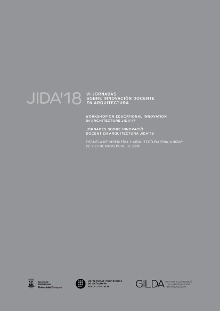The ‘enabling’ master in architecture, an opportunity for an experiential learning
DOI:
https://doi.org/10.5821/jida.2018.5518Abstract
The schools of architecture have recently converted the former Final Project in a one year ‘enabling’ master. This is a colateral efect of the adecuation of the spanish universitarian studies in the european reglamentation. The Escola Tècnica Superior d’Arquitectura del Vallès (ETSAV) treated to implement a pedagogical model that permits to learn from the interaction with ‘the people’ and from the construction experimentation. The paper reviews the theoretical basis of this model and makes a critical approach of the three first years of the ETSAV ‘enabling’ master.
References
DE CARLO, G. (1980). “An architecture of participation†en Perspecta vol. 17, p. 74-79. [on-line from JSTOR]
ESCOLA TÈCNCIA SUPERIOR D’ARQUITECTURA DEL VALLÈS (2018). Mà ster Universitari en Arquitectura. < https://marq.etsav.masters.upc.edu/ca> [Consulta: 15 de septiembre de 2018].
España, Orden EDU/2075/2010, de 29 de julio, por la que se establecen los requisitos para la verificación de los tÃtulos universitarios oficiales que habiliten para el ejercicio de la profesión de Arquitecto.
España, RD 1393/2007, de 29 de octubre, modificado por el RD 861/2010, de 2 de julio, por el que se establece la ordenación de los estudios universitarios oficiales.
Europa, Directiva 2005/36/CE del Parlamento Europeo del Consejo, relativa al reconocimiento de calificaciones profesionales.
FRIEDMAN, Y. (2011). Arquitectura con la gente, por la gente, para la gente. León: MUSAC-ACTAR.
GARCÉS, M. (2014). Un mundo común. Barcelona: Bellaterra.
GARCÉS, M. (2016). Fora de clase. Textos de filosofia de guerrilla. Barcelona: Arcà dia.
HANSEN, O., HANSEN, Z. (1969). “The Open Form in Architecture – the Art of Great Number†en Newman, O. (ed.).
CIAM’59 in Otterlo. Stuttgart: Karl Krämer Verlag.
JACOBS, J. (1967). Muerte y vida de las grandes ciudades. Madrid: Ediciones PenÃnsula.
OCAMICA, I., TUDANCA, I. (2017). “Intervención en el entorno edificado de Mas Vilanova dentro de los lÃmites sostenibles del territorioâ€. Vimeo <https://vimeo.com/243347829> [Consulta: 15 de septiembre de 2018].
PALLASMAA, J. (2012). La mano que piensa. SabidurÃa existencial y corporal en la arquitectura. Barcelona: Gustavo Gili.
RASMUSSEN, S. E. (2000). La experiencia de la arquitectura. Madrid: Mairea / Celeste.
SENNET, R. (2014). L’espai públic. Un sistema obert, un procés inacabat. Barcelona: Arcà dia.
TILL, J. (2005). “What is architectural research? Architectural research: three myths and one model†en Discussion Paper RIBA, London.
TURNER, J.F.C. (1972). “The reeducation of a profesional†en Turner, J.F.C y Fichter, R. (eds). Freedom to Build, dweller control of the housing process. New York: Collier Macmillan.



















